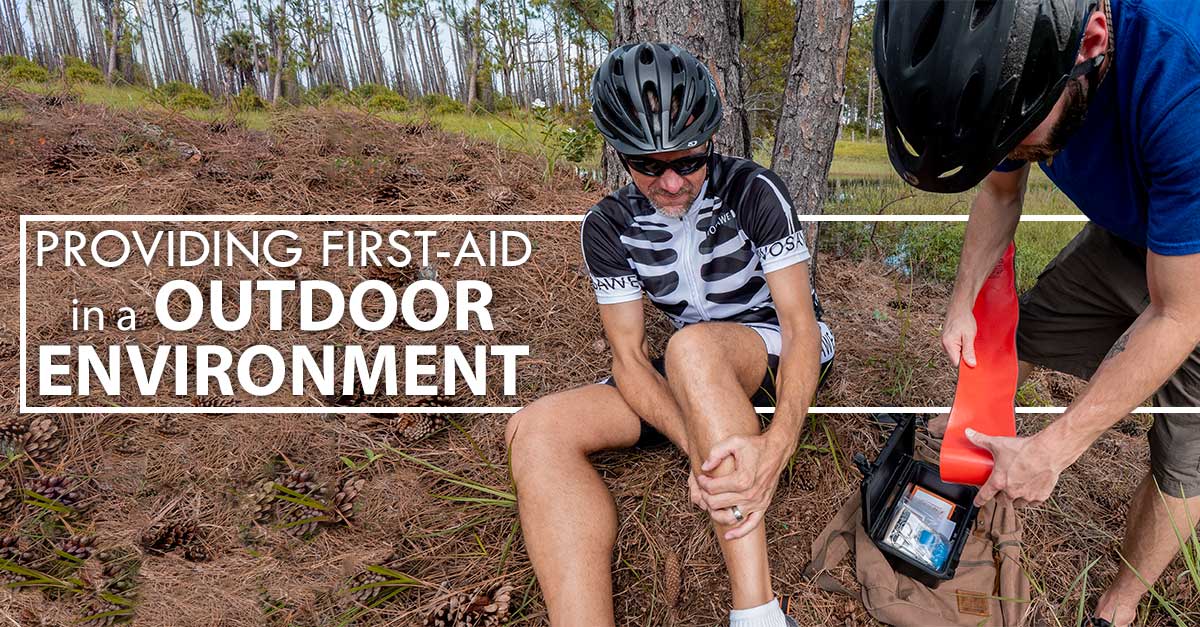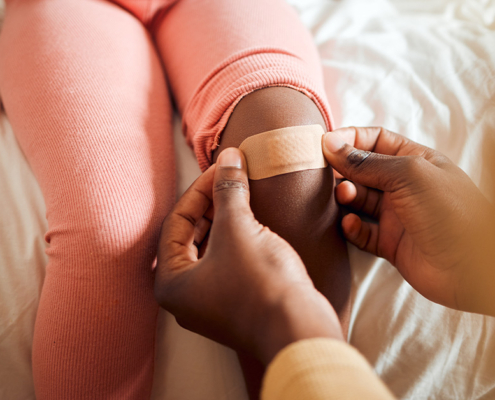Providing First Aid in an Outdoor Environment
By: Mark Powell
Getting outdoors to enjoy our hobbies is a healthy way to spend our time, but whether you are a walker, climber, horse rider, orienteer, angler, mountain biker or trail runner, all outdoor activities carry inherent risks and dangers. Providing first aid in the outdoor environment provides a number of additional challenges not faced in the home, office or urban setting.
While the principles of first aid remain the same, the practical application of those principles will vary depending on the environment. In this article, we are going to look at first aid application in the outdoor environment, where emergency medical services (EMS) may be a couple of hours away. For example, when running or hiking in a local forest or climbing, cycling or horse riding at a large national park. We will not cover cases where help is more than a couple of hours or even days away, such as climbing a remote or very high peak, sailing across the Atlantic, etc. In these cases, the considerations are even greater. For a situation such as this, we are now looking more at wilderness first aid, which is a more specialized field.
Time to treatment.
One of the key features of first aid is that it only provides the initial stages of care in the chain of survival. Early transfer to emergency medical services is one of the aims of first aid. In an urban setting, we rely on ambulance crews and paramedics to provide assistance and medical care.
Response times for EMS will vary depending on your location but when we are looking at an outdoor location it will almost always involve a longer response time before emergency medical services will arrive. This means that the timeframe over which the first responder provides first aid will be longer, and the chain of survival is stretched. If providing CPR over an extended timeframe, the first responder will need to consider the best use of available resources to raise the alarm and provide CPR without risking exhaustion of themselves and other rescuers. For other injuries, such as broken bones, that would normally be immobilized and left to the emergency services to splint, there may be a need for more in-depth initial first aid from the first responder. With extended time until emergency services arrive, the first responder will also have to be careful to reduce the risk of hypothermia for the casualty. Keeping up the spirits of an injured but conscious casualty is probably one of the most important things that the first aid provider can do. This is challenging to achieve over an extended period when the casualty is in pain and may be getting cold or becoming demoralised.
Location and evacuation.
In addition to EMS taking longer to arrive on the scene, first aid in an outdoor location introduces additional complications. Guiding emergency services to the right location is more difficult in an outdoor or rural location. Postal addresses or postcodes/zip codes do not work in the middle of a forest or on a mountainside, and a postcode/zip code may cover a large physical area in a rural location.
This is one area where technology can help. Emergency services can often lock onto the phone signal of a mobile phone to pinpoint the caller’s location or can have you use the GPS function of your phone to determine your exact position. Many emergency services are now recommending the use of the What 3 Words system to provide location information (www.what3words.com). This identifies each 3m3/10ft3 on the planet using a unique combination of three words. For example, the location of the entrance to the First Response Training International HQ is spun.gifted.handwriting.
Of course, all this technology is only useful if you have a mobile phone signal. Areas without mobile phone signals present an increased risk as one of the rescuers may need to travel some distance to find a signal to be able to call for assistance. If you are the only rescuer then you may need to leave the casualty in order to find a signal to call for help.
Managing the evacuation of the casualty may also be more of a challenge. The first aid provider and the casualty may need to perform a self-evacuation. In some cases, a full evacuation will be required while in other cases a partial evacuation may be required in order to make it easier for EMS to reach the casualty. It is possible that the use of specialist services, such as mountain rescue, lifeboat services or even helicopter evacuation, may be required to transport the casualty to a point where EMS can take over.
Lack of resources, improvisation.
A further complication in outdoor first aid is limited access to first aid resources. You may carry a basic first aid kit in a pack or on a belt but if an accident occurs while out running in the forest there may be no traditional first aid supplies available at all. In this case, the use of improvised resources may be the only option. Clothing can be used to apply pressure to bleeding and a t-shirt can be improvised into a bandage or sling. Sports equipment or even branches may need to be used as a splint or a crutch. This might raise an eyebrow amongst those used to carrying out first aid in an office with the benefit of a fully stocked first aid kit or amongst EMS with their impressively equipped ambulances, but the ability to improvise and use whatever is available is essential when conducting first aid in an outdoor situation.
Unfortunately, outdoor activities often present more risks than indoor activities while also introducing many more challenges when dealing with a first aid situation. Fortunately, with some preparation in terms of equipment and training, it is possible to deal with many of the first aid situations that may arise.
If you are likely to be performing first aid in an outdoor, rural or marine environment, then seek out a first aid instructor who has experience performing first aid in these environments and can provide practical, experience-based tips on how to perform the best possible first aid in these situations. They will also be able to provide guidance on the contents of a first aid kit for the specific application.












Erstelle eine Antwort
Möchtest du an der Diskussion teilnehmen?Es steht dir frei etwas beizutragen!